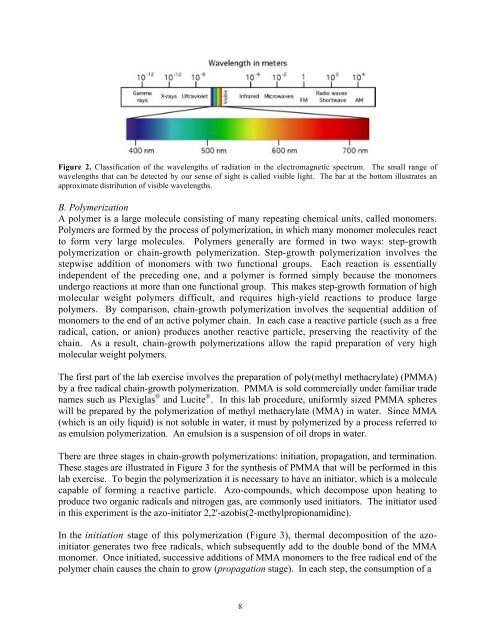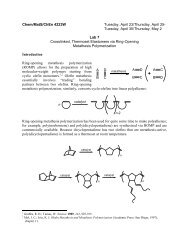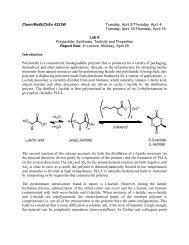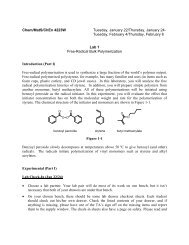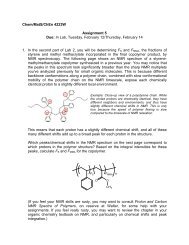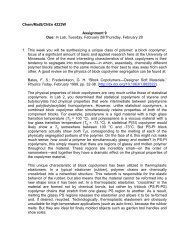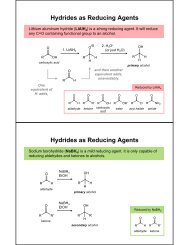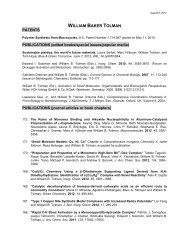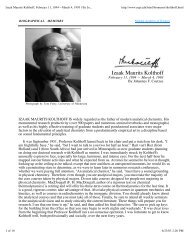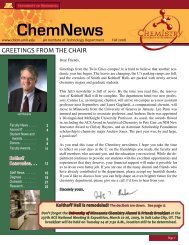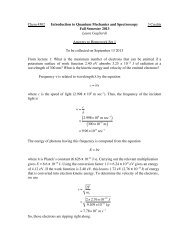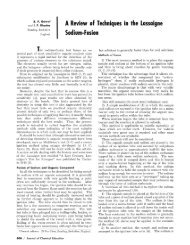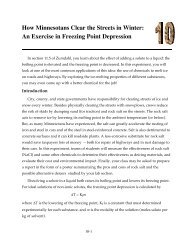Inverse Opal Photonic Crystals - Department of Chemistry ...
Inverse Opal Photonic Crystals - Department of Chemistry ...
Inverse Opal Photonic Crystals - Department of Chemistry ...
You also want an ePaper? Increase the reach of your titles
YUMPU automatically turns print PDFs into web optimized ePapers that Google loves.
Figure 2. Classification <strong>of</strong> the wavelengths <strong>of</strong> radiation in the electromagnetic spectrum. The small range <strong>of</strong><br />
wavelengths that can be detected by our sense <strong>of</strong> sight is called visible light. The bar at the bottom illustrates an<br />
approximate distribution <strong>of</strong> visible wavelengths.<br />
B. Polymerization<br />
A polymer is a large molecule consisting <strong>of</strong> many repeating chemical units, called monomers.<br />
Polymers are formed by the process <strong>of</strong> polymerization, in which many monomer molecules react<br />
to form very large molecules. Polymers generally are formed in two ways: step-growth<br />
polymerization or chain-growth polymerization. Step-growth polymerization involves the<br />
stepwise addition <strong>of</strong> monomers with two functional groups. Each reaction is essentially<br />
independent <strong>of</strong> the preceding one, and a polymer is formed simply because the monomers<br />
undergo reactions at more than one functional group. This makes step-growth formation <strong>of</strong> high<br />
molecular weight polymers difficult, and requires high-yield reactions to produce large<br />
polymers. By comparison, chain-growth polymerization involves the sequential addition <strong>of</strong><br />
monomers to the end <strong>of</strong> an active polymer chain. In each case a reactive particle (such as a free<br />
radical, cation, or anion) produces another reactive particle, preserving the reactivity <strong>of</strong> the<br />
chain. As a result, chain-growth polymerizations allow the rapid preparation <strong>of</strong> very high<br />
molecular weight polymers.<br />
The first part <strong>of</strong> the lab exercise involves the preparation <strong>of</strong> poly(methyl methacrylate) (PMMA)<br />
by a free radical chain-growth polymerization. PMMA is sold commercially under familiar trade<br />
names such as Plexiglas ® and Lucite ® . In this lab procedure, uniformly sized PMMA spheres<br />
will be prepared by the polymerization <strong>of</strong> methyl methacrylate (MMA) in water. Since MMA<br />
(which is an oily liquid) is not soluble in water, it must by polymerized by a process referred to<br />
as emulsion polymerization. An emulsion is a suspension <strong>of</strong> oil drops in water.<br />
There are three stages in chain-growth polymerizations: initiation, propagation, and termination.<br />
These stages are illustrated in Figure 3 for the synthesis <strong>of</strong> PMMA that will be performed in this<br />
lab exercise. To begin the polymerization it is necessary to have an initiator, which is a molecule<br />
capable <strong>of</strong> forming a reactive particle. Azo-compounds, which decompose upon heating to<br />
produce two organic radicals and nitrogen gas, are commonly used initiators. The initiator used<br />
in this experiment is the azo-initiator 2,2'-azobis(2-methylpropionamidine).<br />
In the initiation stage <strong>of</strong> this polymerization (Figure 3), thermal decomposition <strong>of</strong> the azoinitiator<br />
generates two free radicals, which subsequently add to the double bond <strong>of</strong> the MMA<br />
monomer. Once initiated, successive additions <strong>of</strong> MMA monomers to the free radical end <strong>of</strong> the<br />
polymer chain causes the chain to grow (propagation stage). In each step, the consumption <strong>of</strong> a<br />
8


